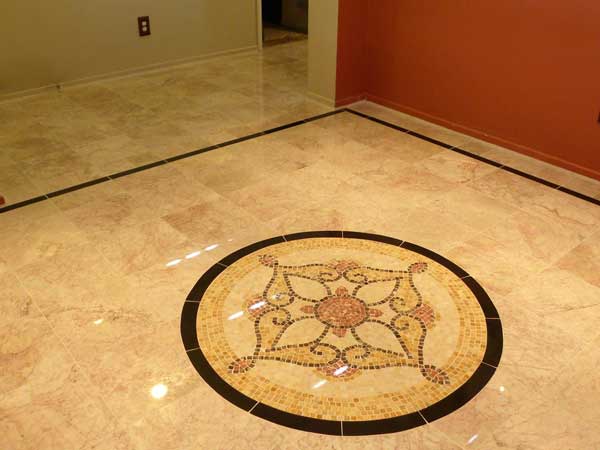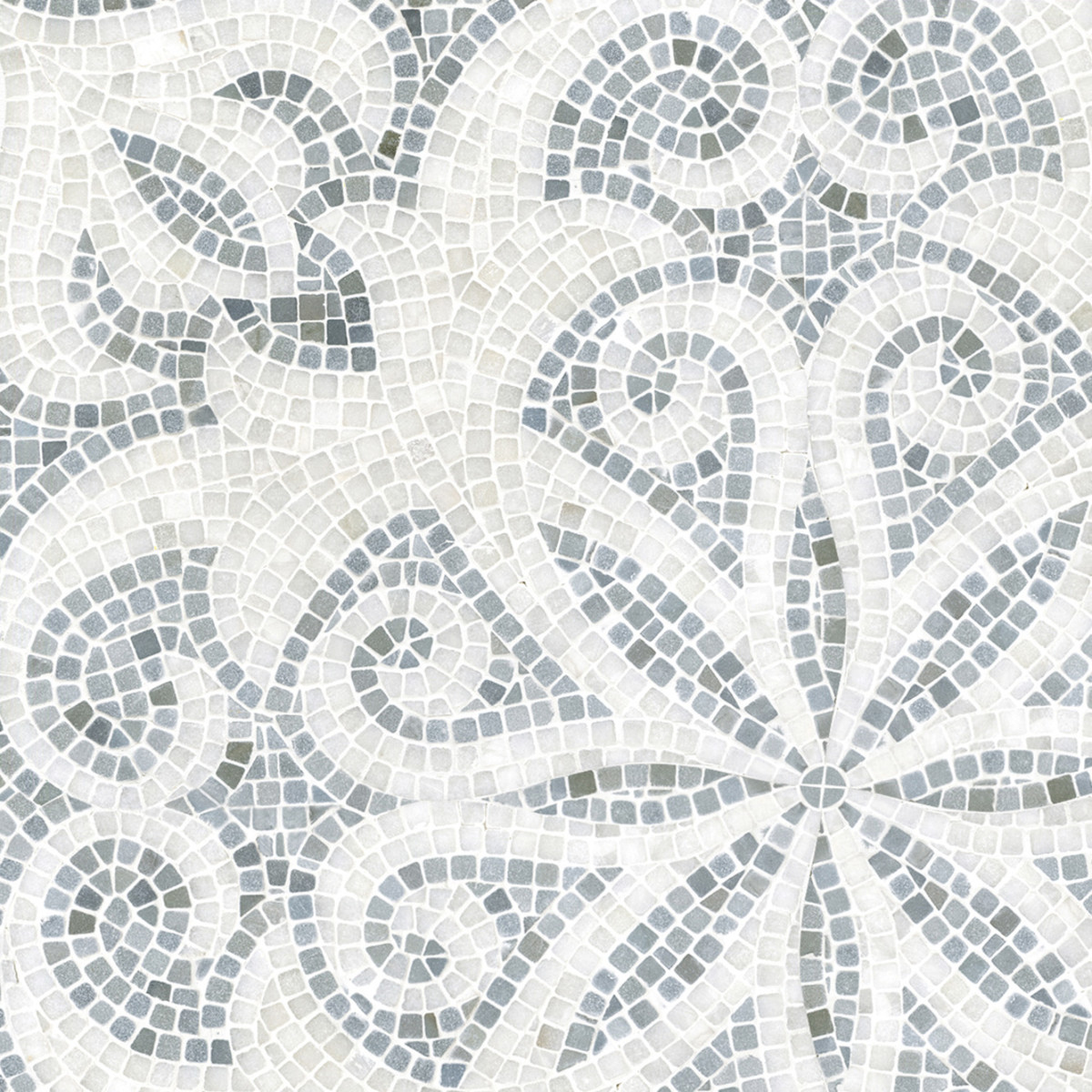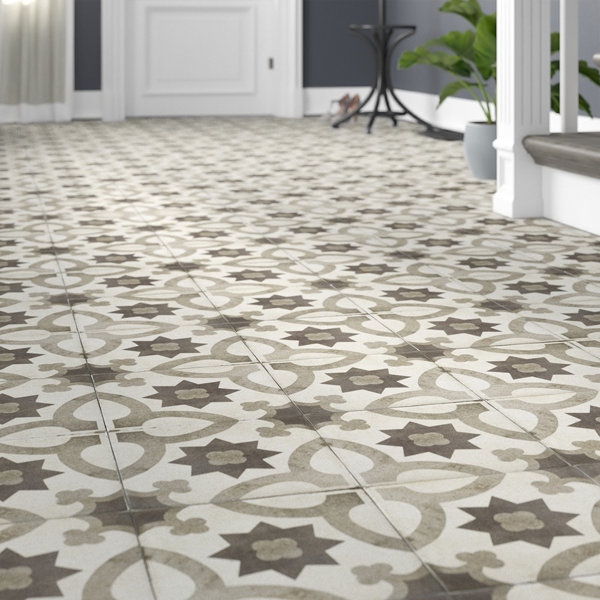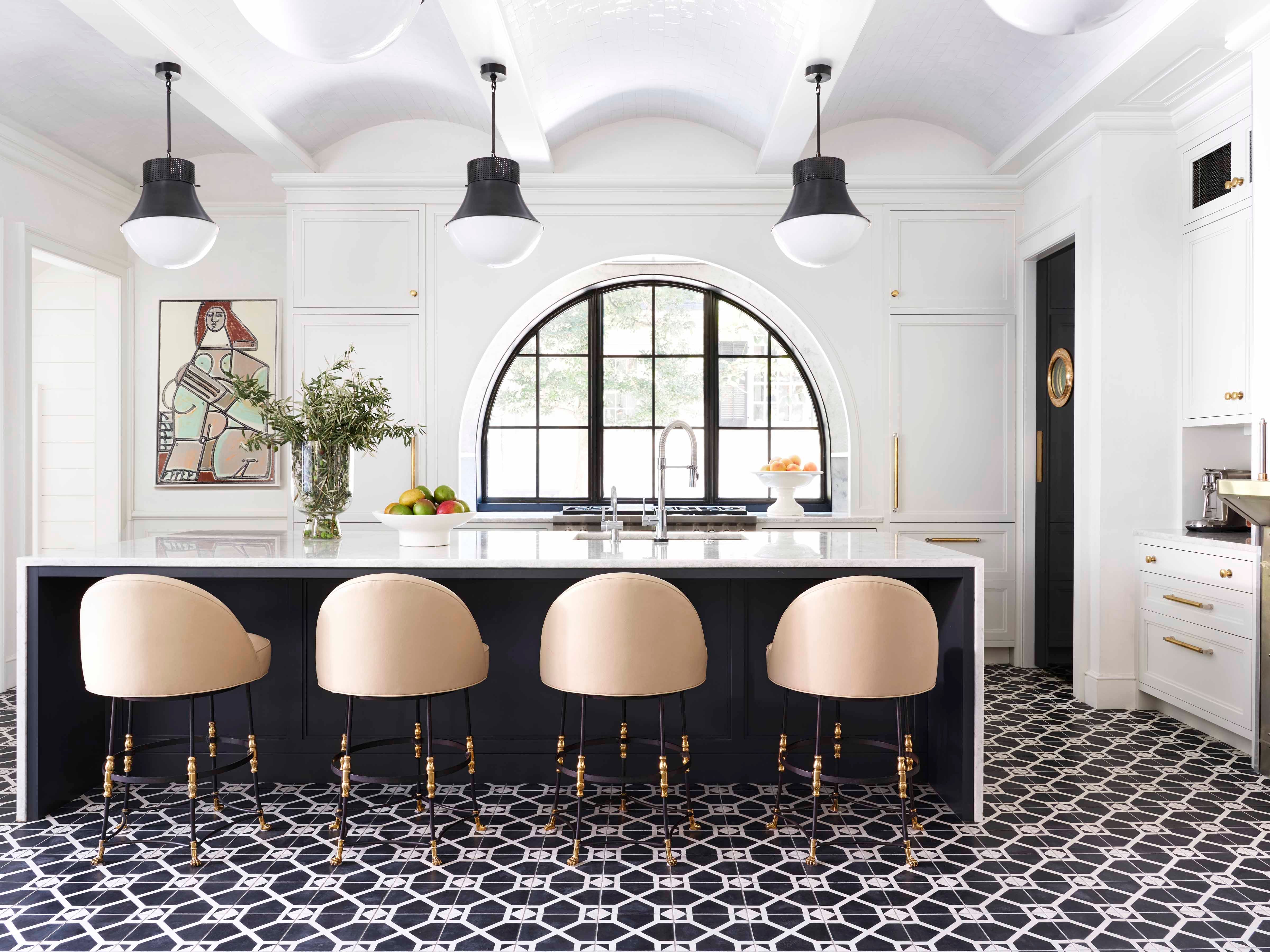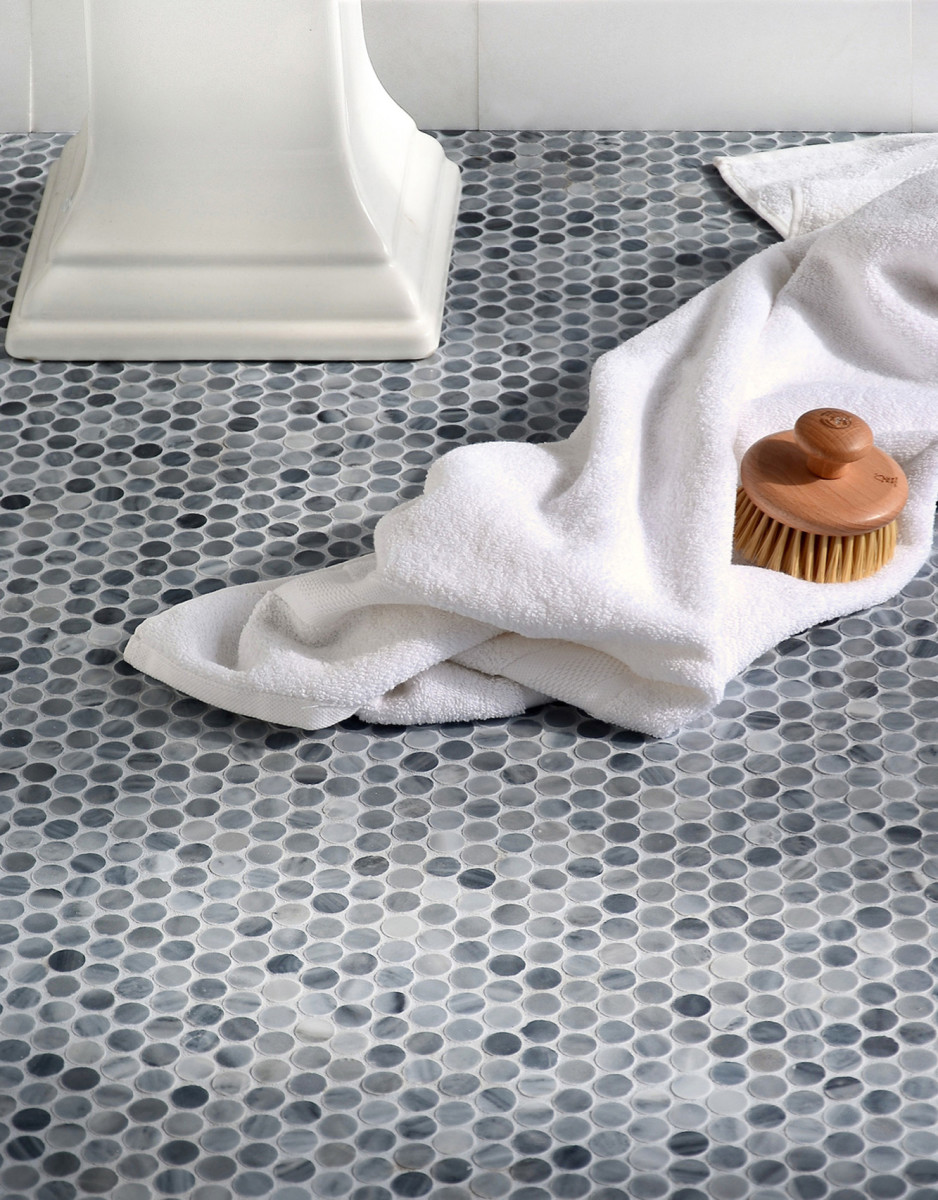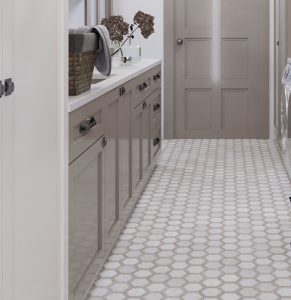Types of Mosaic Tiles: Materials and Styles
Diving into the world of mosaic tiles can be both exciting and overwhelming, given the vast array of materials and styles available. Each type of mosaic tile offers its own unique set of characteristics, making it important to choose the right one for your specific needs and aesthetic preferences. Let’s discuss some of the most popular materials and styles of mosaic tiles.
- Glass Mosaic Tiles: Glass mosaic tiles are known for their vibrant colors and reflective properties. They can add a touch of luxury and brightness to any space. These tiles are often used in bathrooms and kitchens because of their resistance to moisture and stains. The smooth surface of glass tiles makes them easy to clean, and they can be found in a variety of finishes, from glossy to frosted.
- Ceramic Mosaic Tiles: Ceramic tiles are a versatile and affordable option for mosaic floors. They come in a wide range of colors and patterns, allowing for endless design possibilities. Ceramic tiles are durable and easy to maintain, making them a great choice for high-traffic areas. Additionally, they can be glazed to create a shiny, protective surface or left unglazed for a more natural, rustic look.
- Natural Stone Mosaic Tiles: For a timeless and elegant look, natural stone mosaic tiles are an excellent choice. Materials such as marble, travertine, and slate offer unique textures and colors that bring a touch of nature indoors. Each stone tile is unique, adding character and depth to your floor design. While natural stone tiles require more maintenance to prevent staining and damage, their beauty and durability make them a worthwhile investment.
- Metal Mosaic Tiles: Metal mosaic tiles are a modern and stylish option that can add an industrial edge to your space. Made from materials like stainless steel, copper, and aluminum, these tiles are not only durable but also resistant to heat and moisture. Metal tiles are often used as accents or borders to create a striking visual contrast in a room.
- Porcelain Mosaic Tiles: Porcelain tiles are another durable and versatile option for mosaic floors. They are denser and less porous than ceramic tiles, making them even more resistant to moisture and stains. Porcelain tiles can mimic the look of natural stone, wood, or even fabric, offering a wide range of design possibilities. They are suitable for both indoor and outdoor use, adding to their versatility.
- Mixed Material Mosaic Tiles: For a truly unique and personalized look, consider mixed material mosaic tiles. These tiles combine different materials, such as glass, metal, and stone, to create intricate and eye-catching designs. Mixed material tiles can be used to create a focal point in a room or to add texture and interest to a floor.

Popular Patterns in Mosaic Tile Floor Designs
One of the most exciting aspects of designing with mosaic tiles is the array of patterns you can create. From classic designs to contemporary styles, mosaic tile patterns can transform any floor into a work of art. Here are some popular patterns that you can consider for your mosaic tile floor.
Herringbone Pattern
The herringbone pattern is a timeless design that adds sophistication to any space. It involves laying rectangular tiles at a 45-degree angle to create a V-shaped zigzag pattern. This pattern works well with both classic and modern décor and can make small spaces appear larger. Herringbone is particularly popular in entryways and kitchens.
Chevron Pattern
Similar to the herringbone pattern, the chevron pattern also creates a V-shaped design, but the tiles are cut at an angle to form a continuous zigzag. This pattern offers a more seamless and fluid look compared to herringbone. Chevron patterns are perfect for adding a dynamic and trendy touch to a room.
Basket Weave Pattern
The basket weave pattern mimics the look of woven fabric, creating a unique and textured appearance. This pattern is achieved by laying rectangular tiles in pairs, alternating their orientation. Basket weave patterns are often used in bathrooms and kitchens to add visual interest and a touch of nostalgia.
Hexagon Pattern
Hexagon patterns have become increasingly popular in recent years, offering a modern and geometric look. Hexagon tiles can be arranged in various ways, from simple, uniform layouts to more complex, multi-colored designs. This pattern works well in both contemporary and traditional spaces and can be used in kitchens, bathrooms, and even living areas.
Penny Round Pattern
The penny round pattern consists of small, round tiles arranged in a grid or offset layout. This playful and retro design adds a whimsical touch to any room. Penny round tiles are often used in bathrooms and laundry rooms, where their small size and rounded edges create a soft and inviting look.
Moroccan Pattern
Inspired by traditional Moroccan architecture, this pattern features intricate, often colorful designs that can add a touch of exotic elegance to your floor. Moroccan patterns typically involve complex geometric shapes and floral motifs, making them perfect for creating a statement floor. These patterns are ideal for entryways, kitchens, and even outdoor spaces.
Subway Tile Pattern
While traditionally used on walls, the subway tile pattern can also be applied to floors for a clean and classic look. This pattern involves laying rectangular tiles in a staggered brick-like fashion. Subway tile patterns are versatile and timeless, making them suitable for various design styles and rooms.
Choosing the Right Colors for Your Mosaic Tile Floor
Selecting the right colors for your mosaic tile floor is a crucial step in creating a cohesive and aesthetically pleasing design. The color palette you choose will set the tone for the entire room and can influence the mood and perception of space. Here are some tips to help you choose the perfect colors for your mosaic tile floor.
Consider the Room’s Purpose
The function of the room should play a significant role in your color selection. For example, calming and neutral tones are ideal for bedrooms and bathrooms, creating a serene and relaxing atmosphere. In contrast, vibrant and bold colors can energize spaces like kitchens and living areas, making them feel lively and dynamic.
Harmonize with Existing Decor
When choosing colors for your mosaic tile floor, take into account the existing color scheme of the room. Your floor should complement the walls, furniture, and other design elements. If your room already has a lot of color, consider using more subdued tones for the floor to balance the overall look. Conversely, if the room is mostly neutral, a colorful mosaic floor can add a much-needed pop of color.
Use Color Theory
Understanding basic color theory can help you create a harmonious and visually appealing design. Complementary colors, which are opposite each other on the color wheel, create a vibrant and balanced look. Analogous colors, which are next to each other on the color wheel, offer a more subtle and cohesive palette. You can also use monochromatic schemes, which involve different shades of the same color, for a sophisticated and elegant appearance.
Consider the Size of the Space
Color can affect the perception of space. Lighter colors tend to make a room feel larger and more open, while darker colors can create a cozy and intimate atmosphere. If you’re working with a small space, opt for light and neutral tones to enhance the sense of openness. For larger rooms, you can experiment with bolder colors without overwhelming the space.
Think About Maintenance
The color of your mosaic tile floor can also impact its maintenance. Lighter colors may show dirt and stains more easily, requiring more frequent cleaning. Darker colors can help conceal dirt and wear, making them a practical choice for high-traffic areas. Consider the amount of maintenance you’re willing to commit to when selecting your floor colors.
Personal Preference
Ultimately, your taste and style should guide your color choices. Think about the colors that make you happy and feel comfortable. Your home is a reflection of your personality, so choose colors that you love and that resonate with you.
Incorporating Mosaic Tile Floors in Different Rooms
Mosaic tile floors can add a touch of elegance and creativity to any room in your home. Each room presents unique opportunities and challenges for incorporating mosaic tiles, and understanding how to best use them can help you achieve the desired effect. Here are some tips for incorporating mosaic tile floors in different rooms.
Kitchen
In the kitchen, mosaic tile floors can be both functional and stylish. Given the high traffic and potential for spills, choose durable materials like ceramic or porcelain. Consider using mosaic tiles to create a bold, colorful floor that contrasts with neutral cabinets and countertops. You can also use mosaic tiles to define specific areas, such as an island or breakfast nook, adding visual interest and distinction to the space.
Bathroom
Bathrooms are a natural fit for mosaic tile floors due to their water-resistant properties. Glass and ceramic tiles are popular choices for bathrooms. You can create a spa-like atmosphere with calming, neutral tones or add a splash of color with vibrant patterns. Mosaic tiles can also be used to create intricate designs, such as a floral motif or geometric pattern, making your bathroom floor a standout feature.
Living Room
In the living room, mosaic tile floors can serve as a stunning focal point. Consider using natural stone tiles for a sophisticated and timeless look. A large, centrally placed mosaic design can draw the eye and add a touch of luxury to the space. If you prefer a more understated approach, use neutral-colored tiles in a simple pattern to create a cohesive and elegant look that complements your furnishings.
Entryway
The entryway is the first area guests see when they enter your home, making it an ideal spot for a striking mosaic tile floor. Durable materials like porcelain or stone are recommended for this high-traffic area. Consider using a bold pattern or colorful design to make a memorable first impression. Mosaic tiles in the entryway can also be practical, as they are easy to clean and maintain.
Outdoor Spaces
Mosaic tile floors can enhance outdoor spaces such as patios, walkways, and pool areas. Choose tiles that are specifically designed for outdoor use, such as porcelain or natural stone, to withstand the elements. A mosaic design can add a touch of elegance to your outdoor living space and create a seamless transition between indoors and outdoors. Consider using earthy tones and natural patterns to blend with the surrounding landscape.
Laundry Room
The laundry room is another area where mosaic tile floors can shine. Given the potential for water spills, choose moisture-resistant materials like ceramic or porcelain. A colorful mosaic floor can make doing laundry a more enjoyable experience and add a playful touch to the room. Consider incorporating fun patterns or bright colors to create a cheerful and functional space.
Pin on Home decor
Historic Mosaic Patterns for Serviceable Floors – Design for the
Wayfair Floor Tile
Reasons why you should invest in mosaic tile flooring asap
Best Kitchen Floor Tile Ideas
Historic Mosaic Patterns for Serviceable Floors – Design for the
Prism Rosa Polished Marble Mosaic Tile
Reasons to Choose Porcelain Tile
Manufacturer and distributor of high quality glass
How to Cover Ugly Mosaic Tile Floors
Related Posts:
- Dining Room Tile Floor Designs
- Budget Tile Flooring
- Cheap Tile Flooring Ideas
- Restore Tile Floor Shine
- How To Clean Tile Floors With Bleach
- Traditional Bathroom Tile Floor
- Natural Ceramic Tile Floor Cleaner
- Bedroom Tile Floor Ideas
- Commercial Grade Tile Flooring
- Faux Stone Tile Flooring
Introduction
Mosaic tile floor designs are a stunning way to add a unique, luxurious touch to any home. Mosaic tiles are available in a variety of sizes, shapes, and colors, allowing homeowners to create a truly personalized floor design that can be used to enhance the overall look and feel of a home. By using a combination of different mosaic tiles, homeowners can create beautiful patterns that can be used to create a stunning visual effect. Additionally, mosaic tile floors are easy to maintain, providing homeowners with an easy-to-clean flooring option that is both beautiful and long-lasting. In this article, we will discuss the different types of mosaic tile floors available, their benefits, and some tips for creating the perfect mosaic tile floor design.
Types of Mosaic Tile Floors
One of the most popular types of mosaic tile floor designs is the classic checkerboard pattern. This timeless design pairs two alternating colors of tiles in a checkerboard pattern, creating a visually striking effect that is perfect for all types of home décor. Other popular mosaic tile patterns include herringbone, hexagon, and diamond designs. These unique patterns can be used to create dynamic and interesting looks in any room in the house.
In addition to these classic designs, mosaic tiles can also be used to create more intricate floor designs. For example, homeowners can create custom designs by using several different sizes and shapes of tile in their floors. By combining several different sizes and shapes of tiles together, homeowners can create a truly unique mosaic tile floor design that will become the focal point of any room.
Benefits of Mosaic Tile Floors
Mosaic tile floors offer several benefits for homeowners. First, they are easy to clean and maintain. Unlike some other types of flooring, mosaic tile floors are easy to clean with just a mop or vacuum cleaner. Additionally, they are highly durable and long-lasting, making them perfect for high-traffic areas such as kitchens and bathrooms. They also come in a variety of colors, shapes, and sizes so homeowners can easily find the perfect mosaic tile floors for their home décor needs.
Tips for Creating the Perfect Mosaic Tile Floor Design
When creating a mosaic tile floor design, it is important to keep in mind the size and shape of the room in which it will be installed. If you are installing a larger-scale design such as a checkerboard pattern or herringbone pattern, make sure you have enough space for it without overwhelming the room. Additionally, it’s important to consider the size of your tiles when designing your floor – larger tiles may overpower smaller spaces while smaller tiles may become lost in larger spaces.
It’s also important to consider the color palette when designing your mosaic tile floor design. Choose colors that complement each other and enhance your existing home décor. Additionally, if you plan on using several different sizes and shapes of tiles in your design, make sure you lay them out ahead of time so you can get an idea of what your finished product will look like before you begin installation.
Finally, when creating your mosaic tile floor design make sure you leave some space between each tile so that dirt and grime do not become trapped between them over time. This will help keep your floors looking beautiful for years to come!
Q: What type of maintenance do I need to do on my mosaic tile floors?
A: The maintenance required for mosaic tile floors is minimal – all you need to do is sweep or vacuum them regularly to keep them looking their best! Additionally, you may need to spot clean them from time to time if there are any spills or stains.
Q: Can I install mosaic tile floors myself?
A: Yes – installing mosaic tile floors is relatively straightforward but it does require some skill and patience! It’s important to make sure you accurately measure out where each tile will go before starting installation as well as adhere each one properly so that it does not come loose over time. If you’re unsure about how to properly install them yourself then it may be best to hire a professional to do it for you!

